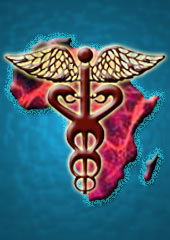Solving Africa’s Public Health Crisis
Can Africa address its serious public health challenges through the strategic use of minimal resources?
November 23, 2007

According to the U.S. Census Bureau, by 2010 sub-Saharan Africa will have suffered 71 million deaths due to AIDS. By comparison, the bubonic plague of the Middle Ages killed some 30 million people. These are staggering figures.
They are echoed by experts at the United Nations, warning that most of the sub-Saharan countries will be unable to reach the Millennium goals related to health set by the international organization for 2015, such as reducing child mortality and improving the health of mothers.
Solving Africa’s health and development problems takes more than statements of good intention, empty promises of aid — or movie stars’ adoption of African children. But there definitely are ways to solve them. In fact, many diseases affecting children and adults can be addressed with minimal resources — if they are used strategically.
Malnutrition is a particularly critical issue. Almost 60% of deaths of children under age five in developing countries are due to malnutrition and its effects on infectious diseases. Malnourished children are up to 12 times more likely to die from easily preventable diseases (such as measles, malaria, diarrhea and pneumonia) than are well-nourished children.
There is a vicious circle between poverty and malnutrition, where each condition increases the negative effects of the other.
To address malnutrition, particularly in children, it is therefore important to educate families on children’s nutritional needs, to ensure food security in poor households and to protect children from infections by immunization and provision of safe water and sanitation. It is also important to focus on poverty, which can act as a jumping board for these situations.
According to UN statistics, African women are ten to 100 times more likely to die during pregnancy and childbirth than women in the industrialized countries. Most of these deaths are caused by delays in recognizing complications, difficulties in reaching a medical facility and lack of adequate medical care.
In addition, for every woman who dies from complications during pregnancy and childbirth, approximately 20 or more endure injuries, infections and disabilities.
Skilled health workers are vital in addressing these challenges — but their numbers are pitifully low. Equally worrisome is the distribution of healthcare workers within the countries themselves, where they tend to remain in urban areas.
Approximately 38 out of 47 countries in sub-Saharan Africa do not meet the WHO recommended minimum of 20 physicians per 100,000 population — and 13 sub-Saharan countries have five or fewer physicians for that same population.
To compound the problem, the exodus of trained personnel to higher paying jobs in industrialized countries is widespread. According to the World Health Organization, 23,000 healthcare workers leave Africa annually. It is estimated that there are more Malawian physicians in Manchester, England, than in Malawi, a country of 12 million people with only 100 doctors and 2,000 nurses.
Both African and industrialized countries have to agree on a set of policies to help health care workers remain in their countries of origin or return to them to provide their services after they have profited from learning in more developed settings.
Malaria, HIV/AIDS and tuberculosis continue to be major threats facing both children and adults. On the age-old issue of malaria, much of the debate is about the highly contentious use of DDT in combating this infectious disease. It need not be the focal point, though.
Recent experiences in Africa and Latin America show that malaria can be controlled without the use of DDT, an important new approach to dealing with this disease. It can be done through rapid case detection, drug treatment and community-level actions.
The focus is on the use of insecticide-impregnated bed nets, sanitation measures to eliminate vector breeding sites — and using chemical substitutes for spraying houses.
Throughout Africa, the stigma associated with HIV/AIDS remains one of the main barriers in dealing successfully with that infection. While education, public health campaigns and the active participation of members of the clergy have contributed in many areas to overcoming the stigma, much remains to be done — and progress is slow.
HIV/AIDS has also had a significant effect on the education sector. In sub-Saharan Africa, the HIV/AIDS pandemic is killing teachers at a rate faster than replacements can be trained. Another effect of the pandemic is teacher absenteeism, loss of educators, planners and management personnel.
It is estimated that close to 30% of teachers in South Africa are HIV positive, a higher rate than among the general population. According to statistics from Zambia’s education ministry, every day one teacher dies from an AIDS-related disease. This is the equivalent of the closure of one school per week due to loss of teachers.
Solving Africa’s persistent health problems requires three distinct steps: First, the development of effective and efficient healthcare systems. Second, increasing healthcare coverage.
And third, redirecting resources from curative care in urban hospitals using resource-intensive high-tech equipment to low-tech community-based primary and preventive care.
To some this may be not focused enough on basic needs, such as a necessary emphasis on putting into place the conditions for sustainable growth.
It is a known fact that any improvement in people’s economic status is immediately followed by an improvement in their nutrition and health. What’s more basic and essential than engendering economic growth?
Health problems in Africa cannot be considered in isolation — and are not only the responsibility of Africans themselves. Foreign technical and financial assistance is required. To be effective, aid must bypass corrupt governments and find ways to help people directly.
The emphasis should be on channeling aid through non-governmental and UN organizations such as WHO, UNICEF and UNFPA with a proven record of effectiveness, and long-standing experience in the countries.
Aid can strengthen civil society and community-based organizations — which are the basis of a democratic society. To bring hope to a continent ravaged by poverty and disease, effective action is required. It can be done.
Read previous
Trade and the Bottom Billion
November 22, 2007
